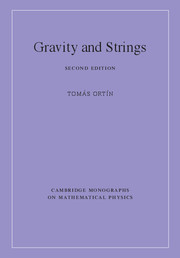Book contents
- Frontmatter
- Dedication
- Contents
- Preface to the second edition
- Preface to the first edition
- Part I Introduction to gravity and supergravity
- Part II Gravitating Point-Particles
- Part III Gravitating extended objects of string theory
- 20 String Theory
- 21 The String Effective Action And T Duality
- 22 From Eleven To Four Dimensions
- 23 The type-IIB superstring and type-II T duality
- 24 Extended objects
- 25 The extended objects of string theory
- 26 String black holes in four and five dimensions
- 27 The FGK formalism for (single, static) black holes and branes
- Appendix A Lie groups, symmetric spaces, and Yang–Mills fields
- Appendix B The irreducible, non-symmetric Riemannian spaces of special holonomy
- Appendix C Miscellanea on the symplectic group
- Appendix D Gamma matrices and spinors
- Appendix E Kähler geometry
- Appendix F Special Kähler geometry
- Appendix G Quaternionic-Kähler geometry
- Appendix H Real special geometry
- Appendix I The generic scalar manifolds of N ≥ 2, d = 4 SUEGRAs
- Appendix J Gauging isometries of non-linear σ-models
- Appendix K n-spheres
- Appendix L Palatini's identity
- Appendix M Conformal rescalings
- Appendix N Connections and curvature components
- Appendix O The harmonic operator on ℝ3 × S1
- References
- Index
25 - The extended objects of string theory
from Part III - Gravitating extended objects of string theory
Published online by Cambridge University Press: 05 April 2015
- Frontmatter
- Dedication
- Contents
- Preface to the second edition
- Preface to the first edition
- Part I Introduction to gravity and supergravity
- Part II Gravitating Point-Particles
- Part III Gravitating extended objects of string theory
- 20 String Theory
- 21 The String Effective Action And T Duality
- 22 From Eleven To Four Dimensions
- 23 The type-IIB superstring and type-II T duality
- 24 Extended objects
- 25 The extended objects of string theory
- 26 String black holes in four and five dimensions
- 27 The FGK formalism for (single, static) black holes and branes
- Appendix A Lie groups, symmetric spaces, and Yang–Mills fields
- Appendix B The irreducible, non-symmetric Riemannian spaces of special holonomy
- Appendix C Miscellanea on the symplectic group
- Appendix D Gamma matrices and spinors
- Appendix E Kähler geometry
- Appendix F Special Kähler geometry
- Appendix G Quaternionic-Kähler geometry
- Appendix H Real special geometry
- Appendix I The generic scalar manifolds of N ≥ 2, d = 4 SUEGRAs
- Appendix J Gauging isometries of non-linear σ-models
- Appendix K n-spheres
- Appendix L Palatini's identity
- Appendix M Conformal rescalings
- Appendix N Connections and curvature components
- Appendix O The harmonic operator on ℝ3 × S1
- References
- Index
Summary
After the general introduction to extended objects of Chapter 24, in this chapter we are going to study specifically the extended objects that appear in string theory. The existence of these objects is implied by our previous knowledge of existing objects (strings and Dp-branes) combined with duality. This path will be followed in Section 25.1, in which we will arrive at the diagrams in Figs. 25.5 and 25.6 that represent, respectively, more-and less-conventional extended string/M-theory objects and their duality relations. The duality relations can be used to find the masses of all these objects compactified on tori (Tables 25.1-25.3) using as input the mass of a string wound once on a circle (i.e. the mass of a winding mode). To obtain consistent results (in particular for electric–magnetic dual branes to coexist satisfying the Dirac quantization condition), the ten-dimensional Newton constant has to have a specific value in terms of the string coupling constant and the string length that we will determine.
The next step (Section 25.2) will be to identify which are, among the general solutions of the p-brane a-model, those that represent the long-range fields of the basic extended objects of string and M theory that we found before. We will first identify families of solutions and then we will study one by one the most important solutions. In Section 25.3 we will check the values of the integration constants of those solutions against the masses and charges of the extended objects that we determined using duality arguments. Then, the duality relations between the solutions will be checked in Section 25.4.
In Section 25.5 we will learn how a great deal of information about all these objects is encoded in the spacetime superalgebras of the effective (supergravity) theories. In particular, the superalgebras tell us (up to a point) which extended objects may exist and the amount of unbroken supersymmetry preserved by each of them (always half of the total), as we will check by solving explicitly the Killing spinor equations (Section 25.5.1).
- Type
- Chapter
- Information
- Gravity and Strings , pp. 724 - 779Publisher: Cambridge University PressPrint publication year: 2015



